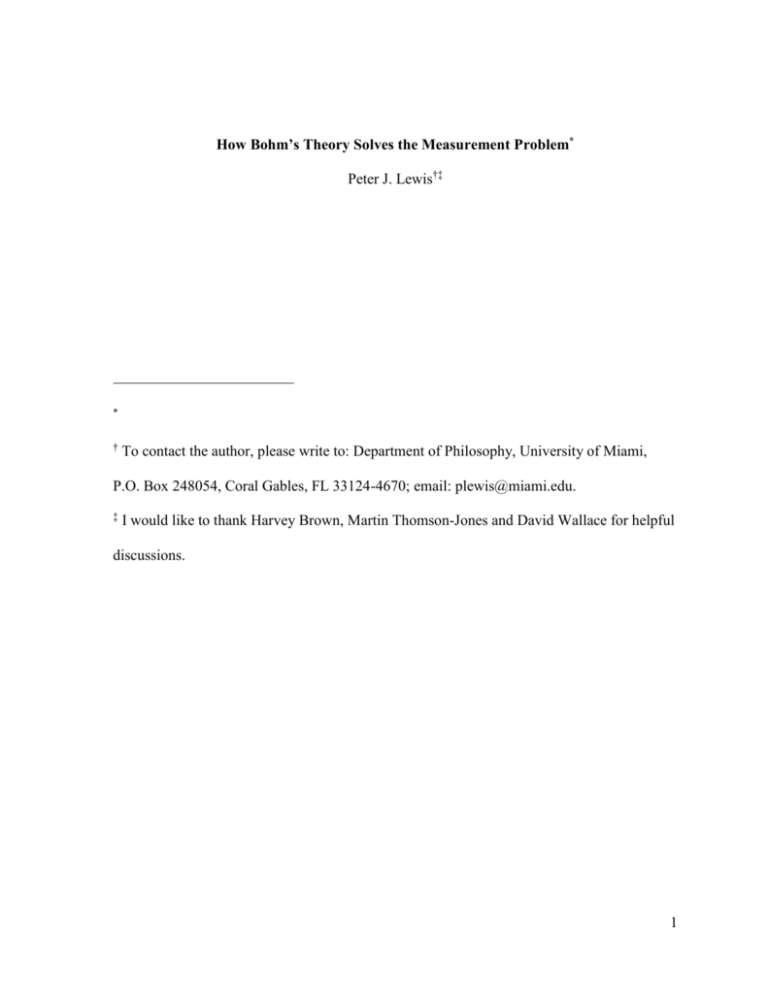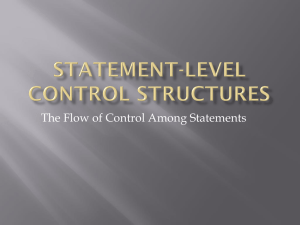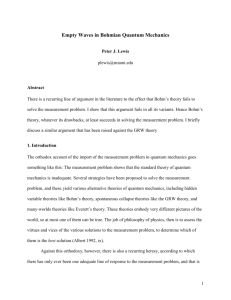- PhilSci
advertisement

How Bohm’s Theory Solves the Measurement Problem* Peter J. Lewis†‡ * † To contact the author, please write to: Department of Philosophy, University of Miami, P.O. Box 248054, Coral Gables, FL 33124-4670; email: plewis@miami.edu. ‡ I would like to thank Harvey Brown, Martin Thomson-Jones and David Wallace for helpful discussions. 1 Abstract I examine recent arguments based on functionalism that claim to show that Bohm’s theory fails solve the measurement problem, or if it does so, it is only because it reduces to a form of the many-worlds theory. While these arguments reveal some interesting features of Bohm’s theory, I contend that they do not undermine the distinctive Bohmian solution to the measurement problem. 2 1. Introduction Bohm’s theory is one of the three “canonical” solutions to the measurement problem in quantum mechanics, along with GRW-type spontaneous collapse theories and Everettian “many-worlds” theories. But despite this status, it is often claimed that Bohm’s theory in fact fails to provide a distinctive solution to the measurement problem, and if it solves the measurement problem at all, it is only because it collapses to a many-worlds theory.1 In this paper, I examine the most recent incarnation of these arguments in the work of Wallace (2003) and Brown and Wallace (2005), and also revisit the debate between Stone (1994) and Maudlin (1995) on the same topic. I conclude that Bohm’s theory has exactly the same credentials for solving the measurement problem as the many-worlds theory, and not because the former reduces to the latter. 2. What it Takes to Solve the Measurement Problem To say more precisely what I mean by “credentials” here, a short preamble on what a theory must do in order to solve the measurement problem will be helpful. The measurement problem, in a nutshell, is the problem that at the end of a measurement, there is nothing in standard quantum mechanics that represents the determinate outcome of the measurement— rather, every possible measurement outcome is represented in some branch of the final wavefunction. So if we take the standard theory seriously as a description of physical systems, then we have no explanation of the fact that measurements have outcomes. A minimal condition, then, for solving the measurement problem, then, is that a theory provides 3 an explanation of our determinate measurement results. This condition leaves open what counts as an explanation, and hence is rather vague, but I do not think it is unconscionably vague. It is clear enough that standard quantum mechanics provides no explanation of the fact that measurements have outcomes, and Bohm’s theory at least prima facie provides such an explanation. So the burden on those who would argue that Bohm’s theory fails to solve the measurement problem is to show how this apparent explanation is deficient. Not everyone uses the phrase “the measurement problem” in the same way. Some people use it to refer to a problem with collapse-on-measurement accounts of measurement outcomes, namely that these accounts treat measurement as an unanalyzed primitive of physical theory. In other words, some people take collapse-on-measurement theories of quantum mechanics to be the source of the measurement problem, rather than a proposed solution. But not much hangs on this choice; even if one uses the phrase “the measurement problem” in such a way that collapse-on-measurement theories solve the problem, such theories are clearly unacceptable precisely because the explanation they propose takes “measurement” as an unanalyzed primitive. So we may as well take the minimal condition for solving the measurement problem to be the following: To solve the measurement problem, a theory must provide an explanation for determinate measurement results that does not take “measurement” as an unanalyzed primitive. Obviously, a theory can satisfy the minimal condition and yet fail to be an acceptable physical theory, for any of a number of reasons. First, we want our quantum mechanical theory to be consistent with our other physical theories, notably special relativity. This 4 condition is notoriously hard to satisfy. Second, and more controversially, we might insist that the theory be consistent with our other philosophical commitments, concerning logic or personal identity or whatever. Of course, many would argue that it is our philosophical commitments that should give way in such situations, and hence dismiss this as a condition on solutions to the measurement problem. But my concern here is not to propose a set of necessary and sufficient conditions for solving the measurement problem; it is rather to note that the claim that a theory solves the measurement problem can mean a number of things. In particular, one might mean that the theory satisfies the minimal condition, or one might mean that, all things considered, it is an acceptable physical theory. The thesis that I defend here is that whatever one means, just as good a case can be made that Bohm’s theory solves the measurement problem as that the many-worlds theory does so. That is, there is no sense of “the measurement problem” in which the many-worlds theory clearly solves it and Bohm’s theory clearly does not. In particular, while the arguments against Bohm’s theory in the recent literature highlight some interesting features of the theory, it is not obvious that these features are problematic, and they certainly do not eliminate Bohm’s theory from contention as a potential solution to the measurement problem. 3. The Functionalist Argument Perhaps the most straightforward version of the anti-Bohmian argument is that of Deutsch (1996). Deutsch notes that the evolution of the wavefunction is exactly the same in Bohm’s 5 theory as in the many-worlds theory; in each theory, the wavefunction always, without exception, evolves according to the Schrödinger equation. In the many-worlds theory, this evolution underlies the branching structure of “worlds”. In particular, during a measurement, each possible measurement outcome is instantiated in some branch of the evolving wavefunction. In Bohm’s theory, too, these branches are all present, but in this case one branch is associated with the Bohmian particles whereas the other branches are “empty”. The Bohmian explanation of the fact that measurements have determinate outcomes is that it is the occupied branch that corresponds to the unique outcome of the measurement. However, Deutsch argues that since the empty branches in Bohm’s theory evolve in exactly the same way as the branches in the many-worlds theory, and that in the many-worlds case this evolution instantiates alternate measurement outcomes, then in the Bohmian case, too, the empty branches contain alternate measurement outcomes. Hence the explanation of determinate measurement outcomes in terms of Bohmian particles fails, since branches instantiate outcomes irrespective of the location of the particles. According to Deutsch, the only sense in which Bohm’s theory solves the measurement problem is that it reduces to a form of the many-worlds theory. In other words, if Bohm’s theory were true, it would still be the case that we obtain determinate results to our measurements, but the explanation of this fact has nothing to do with the Bohmian particles. The correct explanation, according to Deutsch, is that each post-measurement branch of the wavefunction contains a successor of the observer, and each successor sees a unique measurement outcome. But this is precisely the many-worlds explanation. Hence Deutsch 6 concludes that Bohm’s theory is a many-worlds theory “in a state of chronic denial” (1996, 225). Zeh makes essentially the same argument: “Bohm’s theory contains the same “many worlds” of dynamically separate branches as the Everett interpretation (now regarded as empty wave components), since it is based on precisely the same … global wave function” (1999, 200). At least at first glance, though, these arguments seem to miss the point. While it is true that the wavefunction evolution is the same in Bohm’s theory and the many-worlds theory, it only follows that Bohm’s theory yields the same worlds (and the same measurement outcomes) as the many-worlds theory if worlds and measurement outcomes are instantiated by wavefunction evolution. But this, presumably, is precisely what a Bohmian would deny; according to Bohm’s theory, measurement outcomes are instantiated by the evolution of the Bohmian particles, not the evolution of the wavefunction (Lewis 2007). However, there is a more charitable way to interpret these rather brief arguments, namely as implicitly appealing to a variety of functionalism. Wallace makes this functionalist premise explicit: “A macro-object is a pattern, and the existence of a pattern as a real thing depends on the usefulness … of theories which admit that pattern in their ontology” (2003, 93). The basic idea here is that is that if a macro-object is a pattern, then it makes no difference whether that pattern is instantiated in the evolution of the particles or the wavefunction. On this functionalist conception of macro-objects, an empty branch contains exactly the same objects instantiating exactly the same processes as it would contain were it to be occupied by the Bohmian particles, since the pattern is the same in either case. Hence 7 empty branches contain measurement outcomes, and Bohm’s theory fails to solve the measurement problem, except in the sense that it reduces to the many-worlds theory (Wallace 2003, 99). It is this functionalist argument, together with the variants considered below, that I take to be the main challenge to the claim that Bohm’s theory solves the measurement problem. 4. Responses to the Functionalist Argument One response to the above challenge is to claim that the wavefunction is not a physical entity, and hence not the kind of thing in which physical patterns could be instantiated. For example, Dürr, Goldstein and Zanghì (1997) argue that the wavefunction plays the role of a law in Bohm’s theory, a law that directs the motion of the Bohmian particles. If this is tenable, then there are no empty branches in Bohm’s theory, since there are no branches at all—just particles, moving according to a complex law. But the challenge facing this line of argument is that the wavefunction itself is subject to dynamics; it evolves over time, and its form at any particular time is a contingent matter of fact, independent of the configuration of the particles (Deutsch 1996, 225; Brown and Wallace 2005, 532). These are not features we associate with laws. Dürr, Goldstein and Zanghì appeal to work in quantum cosmology that suggests that the wavefunction may turn out to be unique and time-independent, but as Brown and Wallace (2005, 533) note, this is currently no more than a speculative research program. Let us assume, then, that the wavefunction must be treated as a physical entity. Can the force of the functionalist argument nevertheless be resisted? The obvious way to do so is 8 to deny the functionalist premise. The position that ordinary objects are patterns is plausible, but as I have argued previously (Lewis 2007), the many-worlds theory, too, must deny various plausible assumptions if its explanation of our determinate measurement results is to succeed. For example, Greaves (2004, 426–427) suggests giving up the assumption that a subjective probability measure over future events requires uncertainty about what will happen, and Wallace (2006, 672–673) suggests giving up the assumption that uncertainty requires some fact about which one is uncertain. Still, the many-worlds theory certainly satisfies the minimal condition for solving the measurement problem; it provides an explanation of our determinate measurement results, albeit one that violates various plausible assumptions about probability and uncertainty. But by the same token, Bohm’s theory satisfies the minimal condition; it too provides an explanation of our determinate measurement results, albeit one that violates a plausible kind of functionalism about macroscopic objects. So if satisfying the minimal condition is taken as sufficient for solving the measurement problem, then Bohm’s theory clearly counts as a solution, the functionalist argument notwithstanding. But as noted above, one might require more from a solution to the measurement problem; one might require that, all things considered, it is an acceptable physical theory.2 Further, one might take macro-object functionalism to be a precondition for any acceptable physical theory. But this is a strong claim; at least prima facie, it seems conceivable that macro-objects should be tied to a particular ontological basis, namely Bohmian particles. At the very least, the argument for this claim has not yet been made. 9 Furthermore, as noted above, it is just as unclear whether the many-worlds theory is an acceptable physical theory, all things considered. The many-worlds theory, too, violates assumptions that one might take as preconditions on any acceptable theory. Indeed, if one insists on holding tight to all one’s pre-theoretical philosophical assumptions, then there may well be no solutions to the measurement problem. These considerations are, I think, sufficient to address the basic functionalist argument. But up to now I have conceded that Bohm’s theory has a previously unappreciated cost, namely that it requires the rejection of macro-object functionalism. Thus even if the functionalist argument doesn’t by itself show that Bohm’s theory fails to solve the measurement problem, it might be taken as a contribution to the demise of Bohm’s theory as an acceptable physical theory. Perhaps, though, this concession was hasty; let us see whether accepting macro-object functionalism really destroys the Bohmian explanation of determinate measurement results. Recall that macro-object functionalism poses a threat to Bohm’s theory because empty branches exhibit the same patterns that they would exhibit were they to be occupied by Bohmian particles. That is, for any given branch, the pattern of the evolving wavefunction (if empty) and the pattern of the evolving particles (if occupied) are the same pattern. Hence, given macro-object functionalism, the empty branch and the occupied branch contain the same objects and processes; the former contains a measurement result just in case the latter does. But do the wavefunction evolution and the Bohmian particle evolution really constitute the same pattern? Clearly they are different in many respects; the former is the evolution of a 10 continuous field according to the Schrödinger equation, the latter is the evolution of discrete points according to the Bohmian dynamics. The functionalist trick, of course, is to identify the patterns by what they do—by their interactions with other patterns. A particular pattern in the Bohmian particles constitutes the display of a measurement result just because of its correlations with patterns that constitute the state of the measured system and the experiences of the observer. But then one can identify a pattern in the wavefunction evolution of the occupied branch that plays the same functional role; it mediates between a wavefunction pattern of the measured system and a wavefunction pattern of the observer. And this latter pattern can equally well be instantiated in empty branches; hence empty branches can contain measurement results. But identifying patterns in wavefunction evolution is not quite as straightforward as this account suggests, precisely because the wavefunction exists in multiple branches. The pattern that would correspond to some measurement result, were its branch the only branch, is superposed with patterns bear the same relation to the other possible results. What should we say of the resultant wavefunction pattern? Should we say that each of the individual patterns is present in the superposed pattern, or that none of the individual patterns are present in the superposed pattern? Neither answer seems forced on us. Appealing to the functionalist conception of patterns outlined above doesn’t answer the question; if patterns are identified by their relations to other patterns, then one must decide whether the individual patterns are present in the superposition before one can use such relations to identify patterns. Similarly, appealing to decoherence is of no help; once patterns have been identified, 11 decoherence can be used to establish that two patterns evolve independently of each other, but decoherence doesn’t identify patterns. One way the question might be answered is by an appeal to theory. That is, one might read the many-worlds theory as stipulating that each of the individual patterns is present in the superposition. On this view, one might equally well stipulate that the individual patterns are not present in the superposition; the result would be something like Albert’s bare theory (1992, 124). The bare theory is a very poor physical theory for a number of reasons, but the point is that if the existence of these patterns is a matter of theoretical stipulation, then the Bohmian can equally well stipulate that the individual patterns are not present in the superposition. But then the Bohmian can accept macro-object functionalism while avoiding the conclusion that multiple outcomes exist after a measurement. The Bohmian can insist that none of the patterns corresponding to the possible outcomes are present in the wavefunction, but one such pattern is present in the particles. Hence the Bohmian explanation of determinate measurement outcomes is retained, even granting macro-object functionalism. If the foregoing is correct, then the functionalist argument against Bohm’s theory fails at two levels. First, even if macro-object functionalism is granted, it is arguable that Bohm’s theory provides a successful solution to the measurement problem, one that is distinct from the many-worlds solution. Second, to insist that any solution to the measurement problem must be constrained by macro-object functionalism is to impose a double standard, since the many-worlds theory must violate equally well-entrenched philosophical positions. 12 5. Elaborating the Functionalist Argument Brown and Wallace (2005) provide an elaboration of the functionalist argument. They argue first against what they call Bohm’s result assumption—the position that it is the branch of the wavefunction (“wave packet”) containing the particles that determines the outcome of a measurement. They ask us first to consider a case in which only a single wave packet exists at the end of the measurement—that is, a case in which the measurement has exactly one possible outcome. In this “predictable” case, they note, nobody doubts that the wavefunction alone can account for the result of the measurement. But then, they argue, in the general case where the wavefunction consists of a number of distinct packets, each of those packets “has the same credentials for representing a definite measurement outcome as the single packet does in the predictable case. ... The fact that one of them carries the de Broglie-Bohm corpuscles does nothing to remove these credentials from the others” (2005, 524). I think that this argument trades on an ambiguity in what it is that nobody doubts. What nobody doubts is that in the predictable case, the wavefunction alone could explain the measurement result—there is no technical barrier to its doing so. But if read in this way, the inference Brown and Wallace wish to make doesn’t go through. In the general case, people do doubt that the wavefunction alone could be the explanation of our determinate measurement results, precisely because there is a technical barrier to its doing so. The technical barrier is just the fact that in the general case there are several wave packets, and hence no unique measurement outcome; in other words, the technical barrier is precisely the measurement problem. That is, what (many people think) takes away the credentials for 13 representing a definite measurement outcome from a wave packet is the presence of other wave packets, not the presence of Bohmian particles. On the other hand, if the claim is that, in the predictable case, the wavefunction alone does explain the measurement, then the inference may well go through. It would at least be rather ad hoc for a theory to specify that the measurement result is determined by the wavefunction in the predictable case but by the Bohmian particles in the general case. So if the wave packet does in fact determine the measurement result in the predictable case, it seems reasonable to conclude that each wave packet determines a measurement result in the general case. But if that is the argument, it begs the question against the Bohmian. The Bohmian will insist that even in the predictable case, it is the particle configuration, not the wave packet, that determines the measurement result. That is, even though the wave packet could determine the measurement result in the predictable case, in the sense described above, as a matter of fact, given Bohm’s theory, it does not. In a sense, though, Brown and Wallace are right, since the Bohmian position outlined in the previous paragraph amounts to a rejection of Bohm’s result assumption. Bohm’s result assumption says that it is the wave packet containing the particles that determines the measurement outcome, whereas what the Bohmian should say is that the particles themselves determine the outcome. In fact, this is precisely what Bohmians do say; as Brown and Wallace admit, probably no Bohmian, including Bohm himself, has ever seriously advocated Bohm’s result assumption (2005, 523). Hence an argument against Bohm’s result assumption is not, by itself, an argument against Bohm’s theory. However, what Brown and Wallace are 14 concerned to establish here is that Bohm’s result assumption is an unstable position; if one attempts to associate the measurement outcome with the wave packet containing the particles, one will be forced to associate measurement outcomes with empty packets too. Then their strategy in the remainder of the paper is to argue that, despite their protestations to the contrary, Bohmians are tacitly committed to something like Bohm’s result assumption, and in particular, that measurement results cannot, after all, be determined directly by the particle configuration. The argument has to do with our knowledge of the particle configuration. Bohmians frequently point out that according to Bohm’s theory, one cannot know the particle configuration exactly. In fact, the theory entails that the best one can do is to have one’s probability distribution over the possible particle configurations determined by the squared amplitude of the wavefunction. That is, the squared wavefunction amplitude functions as a lower bound on the accuracy of our determinations of the particle configuration. But this can’t be exactly right; the wavefunction, after all, doesn’t determine a unique result for a measurement. So Bohmians note that since an observer can know which wave packet contains the particles, the lower bound on the accuracy with which the particle configuration can be known is actually the squared amplitude of the occupied wave packet. This raises two worries. First, there is a tension in the theory as just sketched; how can we know which packet contains the particles if the squared wavefunction amplitude constitutes a lower bound on the accuracy with which the particle configuration can be known? Second, even if this story can be told, it begins to look as though the occupied wave packet, rather than the 15 particle configuration, is playing a central role in determining our beliefs about measurement results, so that the Bohmian is committed to Bohm’s result assumption after all. Brown and Wallace fill out this argument by referring back to the debate between Stone (1994) and Maudlin (1995) on the status of Bohm’s theory. Consider how measurement results might be determined by particle configurations. Presumably the particle configuration corresponding to the measurement result becomes correlated with a particle configuration in the brain of the observer. But how is the observer aware of the particle configuration in her brain? Stone argues that if her knowledge of the position of the particles is based on something like a measurement by one part of her brain on another part of her brain, then she can never know which wave packet contains the particles. This is a straightforward consequence of the result cited above; according to Bohm’s theory, a measurement can never determine the locations of the particles with greater accuracy than the squared wavefunction amplitude, and the squared wavefunction amplitude, of course, doesn’t determine which wave packet contains the particles. If this is the correct story about how observers come to know measurement results, then Bohm’s theory clearly fails to account for our knowledge of measurement results. However, Maudlin responds that measurement of one part of the brain by another is entirely beside the point; the fact that the particle configuration in the observer’s brain is correlated with the particle configuration of the measured system is sufficient for the observer to know the result of the measurement. But as Brown and Wallace point out, “Maudlin seems to be taking it for granted that our conscious perceptions supervene directly and exclusively on the 16 configuration of (some subset) of the corpuscles associated with our brain” (2005, 534). This direct supervenience of experience on particle configuration, they think, is problematic, precisely because it allows for more accurate knowledge of the particle configuration than is afforded by the squared wavefunction amplitude. In particular, a result by Valentini (1992) suggests that knowledge of this kind would allow us, in principle, to violate the quantum nosignaling theorem (i.e. to send superluminal signals). One could retreat to the position that it is just the wave packet containing the particles that is directly known, but this would be to endorse Bohm’s result assumption, and hence open the door to the argument at the beginning of this section. The argument here has the form of a trilemma. How are we aware of the particle configuration in our brains? If via measurement, then we can never know the particle configuration. If directly, then the quantum no-signaling theorem does not apply to Bohm’s theory. And if via the wave packet containing the particles, then we are back at Bohm’s result assumption. The right response, I think, is to endorse the second option, but to note just how imprecise the supervenience of our experience on the particle configuration is likely to be. The supervenience of the mental on the physical is (presumably) at something like the level of neural processes, but specifying the neural processes leaves a huge amount of leeway in the possible Bohmian particle configurations. That is, an observer who is directly aware of a particular neural process will know her own physical state with far less precision than is given by the squared wavefunction amplitude. 17 Indeed, Brown and Wallace concede as much: “Considerable variation in the precise configuration of the corpuscles in our brain must be unobservable. How much? Not even the effective wavefunction of our brain can be known precisely; even Everettians must admit there is a many-one relationship between wavefunctions of the brain and conscious sensations” (2005, 535). So as a matter of fact, we do not know our own brain states with enough precision to allow superluminal signaling. Still, there is the matter of principle; if Bohm’s theory is true, then it looks like there is no reason in principle why an organism should not know its own particle configuration with enough precision to allow superluminal signaling. This will depend on tricky issues concerning what kinds of physical processes could in principle provide the supervenience basis for the experiences of an organism. But this is a point that the Bohmian should probably just concede. As Albert has independently pointed out, very strange consequences follow if an organism can be directly aware of the precise location of a Bohmian particle in its brain (1992, 170–176). This is an oddity of Bohm’s theory, and worth pointing out, but not clearly an objection to it. 6. Conclusion I have argued that the functionalist argument, in all its guises, fails to undermine the claim of Bohm’s theory to offer a distinctive solution to the measurement problem. In particular, no form of the argument succeeds in showing that Bohm’s theory is really just a disguised many-worlds theory. Nevertheless, the various forms of the functionalist argument raise interesting issues concerning the comparative merits of Bohm’s theory and the many-worlds 18 theory. In particular, the extent to which Bohm’s theory relies on the rejection of some form of macro-object functionalism is a topic that deserves further investigation. 19 References Albert, David Z. (1992), Quantum Mechanics and Experience. Cambridge, MA: Harvard University Press. Brown, Harvey R. and David Wallace (2005), “Solving the Measurement Problem: de Broglie-Bohm Loses Out to Everett”, Foundations of Physics 35: 517–540. Cordero, Alberto (1999), “Are GRW Tails as Bad as They Say?”, Philosophy of Science 66: S59–S71. Deutsch, David (1996), “Comment on Lockwood”, British Journal for the Philosophy of Science 47: 222–228. Dürr, Detlef, Sheldon Goldstein and Nino Zanghì, (1997), “Bohmian Mechanics and the Meaning of the Wave Function”, in R. S. Cohen, M. Horne, and J. Stachel, (eds.), Experimental Metaphysics: Quantum Mechanical Studies for Abner Shimony, Volume One (Boston Studies in the Philosophy of Science, Volume 193). Dordrecht: Kluwer, 25–38. Greaves, Hilary (2004), “Understanding Deutsch’s Probability in a Deterministic Multiverse”, Studies in History and Philosophy of Modern Physics 35: 423–456. Lewis, Peter J. (2007), “Empty Waves in Bohmian Quantum Mechanics”, British Journal for the Philosophy of Science, forthcoming. Maudlin, Tim (1995), “Why Bohm’s Theory Solves the Measurement Problem”, Philosophy of Science 62: 479–483. 20 Stone, Abraham D. (1994), “Does the Bohm Theory Solve the Measurement Problem?”, Philosophy of Science 61: 250–266. Wallace, David (2003), “Everett and Structure”, Studies in the History and Philosophy of Modern Physics 34: 87–105. ——— (2006), “Epistemology Quantized: Circumstances in Which We Should Come to Believe in the Everett Interpretation”, British Journal for the Philosophy of Science, 57: 655–689. Valentini, Antony (1992), On the Pilot-Wave Theory of Classical, Quantum and Subquantum Physics. Ph.D. Dissertation. Trieste, Italy: International School for Advanced Studies. Zeh, H. Dieter (1999), “Why Bohm’s Quantum Theory?”, Foundations of Physics Letters 12: 197–200. 21 FOOTNOTES 1 The same charge has been leveled against spontaneous collapse theories (Cordero 1999); see Lewis (2007) for a brief discussion. 2 One might quite reasonably contend that Bohm’s theory is unacceptable as a physical theory because it conflicts with special relativity. However, since the functionalist argument makes no mention of relativity, and since it is unclear whether the many-worlds theory fares any better in this regard, I leave the issue to one side. 22







